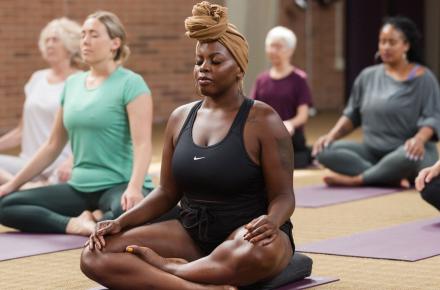Two Practices for Creating More Space in Your Mind and Your Life


Creating space is different from “letting things go.” I once believed that I needed to let go of certain things, because I thought the stuff I was holding on to must be “bad” parts of me. That perspective reinforced the idea that I had to get rid of something or I wouldn’t be okay. It felt like a little war was going on inside me.
I am no longer fond of the concept of letting things go, because it implies that we need to eliminate something from our life, and that idea can create more tension. The truth is, we are all a walking summary of our life experiences—everything we’ve taken in, good and bad.
So instead of trying to “let things go,” I invite students to “let things be.” This is the attitude from which we can make space. Rather than pushing parts of us away, we are instead creating an environment that allows us to simply loosen our grip. We don’t have to fix anything. All we’re doing is bringing tender, nonjudgmental attention to our body and making room for whatever is living there. This is how the process of sustainable change begins.
Here are two exercises to support you in creating space.
Two-Minute Retreat and Re-Center
Pause for two minutes with this simple meditation to feel more grounded and centered.
- Settle back into your chair. Be in an easy, comfortable position. Feel where your body meets support.
- Release a couple of long exhales out through your mouth. With each exhale, allow your weight to drain down from your head and shoulders, into your seat and legs.
- Just as the sand in an hourglass drains from the top half to the bottom, imagine, all the heaviness, all the “sand” in you, draining from your head, shoulders, and torso, down into your bottom half. Allow your weight to rest heavily in your seat.
- Move your awareness back to the center of the chest. Welcome the breath into your clear upper hourglass. As if there were a nostril on the heart, imagine your breath moving freely through your chest.
- Feel the nourishing breath flowing, caring for you, as it moves in and out.
- Slowly open your eyes and transition with ease into your next moment.
Mindful Meditation on the Breath
- Sit in a comfortable position, either in a chair or on the floor, with your back straight but as relaxed as possible. Allow the center of your earlobes to line up over your shoulders, which in turn line up over your hips.
- Begin with a couple of deep, conscious breaths with eyes closed, breathing through your nose. Let your mind be absorbed by your breath.
- Focus on your breath—cool air in, warm air out. When you feel comfortable and ready, begin to count your breaths.
- Count up to four and then repeat. It goes like this: inhale and count one; exhale; inhale and count two; exhale; inhale and count three; exhale; inhale and count four; then repeat.
- If your mind wanders, gently bring it back to the breath and your counting. Don’t worry if you lose count; simply start at one again. The important thing is to enjoy your meditation, so start out slowly. On your first attempt only meditate for two to five minutes. Build up over time.
This article was excerpted from Jillian's Yogalicious blog.


















































